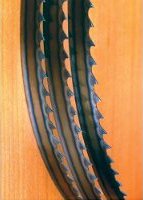Buying a Band Saw: Band Saw Basics
❈ Bring Out the Band Saws by Curtis Rist
A circular saw may be portable, and a jig saw may be able to make a plunge cut into the center of a piece of wood, but only a band saw can produce a truly finished piece of wood. As the thin steel blade zips along at upwards of 2,000 feet per minute, the wood it parts emerges with a clean edge, as if it's been polished with fine-grain sandpaper.
A band saw gets its name from the blade itself, a giant loop that's stretched between two or three wheels and pulled through a small hole in a cutting table. Its blade is thin - far thinner than that of a circular saw - and can cut not only straight lines, but also graceful curves. This makes band saws a favorite among everyone from boat builders to furniture makers. With the right blades, these versatile saws can cut plastic and metal as well as wood.

16" Resaw capacity for cutting large pieces of wood, slicing veneers and cutting book matched panels.
Special Features:
▸ 27¼" x 20" Precision ground cast iron table
▸ Micro-adjustable fence, dual-position side plate
▸ Upper and lower ball bearing guides
▸ Rigid, four-sided guide post
▸ Rack and pinion adjustment for optimum blade support
▸
Buy @ Amazon.com
▸
Universal Mobile Base
☑ Band Saw Basics
▸
Heft
You can't just toss a band saw into your toolbox the way you can a circular saw. The biggest floor models, which can cut massive beams lengthwise, weigh nearly a ton. There are more modest versions that sit on special stands, but even smaller bench-top versions, which might be considered portable, would be hefty to tote.
▸
Measurements
Regardless of their overall dimensions,
band saws are classified by the diameter of the wheels that hold their blade in place. That dimension is slightly greater than the one that really counts:
throat capacity. Measured by the distance between the blade and the throat--the supporting post that connects the top and bottom wheels--throat capacity determines the maximum width of board the saw can handle.
The depth of the cut that can be made is determined by another measurement altogether - namely, how far the upper blade guide can be maneuvered above the table. Bench-top models might eke out a cut just over 3" deep, those on stands might go to 6", and giant floor models may be able to cut 12" or more.
▸
Horsepower
An underpowered tool will labor under the effort of the work and cut slowly, resulting in burns in the wood from the accumulating friction. To avoid this, you need a saw that has the appropriate horsepower for the job. For instance, if you're cutting through 3" or more of hardwood, you'll need a saw with at least a ½ horsepower motor. To make cuts of up to 6" deep, go with a ¾ horsepower motor. To saw beams, you'll need a giant machine with about 3 horsepower.
☑ Timber Wolf Bandsaw Blades:

Timber Wolf makes the worlds only thin-kerf, low tension, silicon steel bandsaw blades that will outlast your old carbon steel blades by a mile! Your bandsaw will cut better and faster, with less wear on bearings, shafts and tires. Tooth angles and gullet symmetries, combined with a unique set pattern, create a blade that is everything a wood-cutting blade was meant to be.
Shop for Timber Wolf Bandsaw Blades:
▸
Timber Wolf Bandsaw Blades: 93½"
▸
Timber Wolf Bandsaw Blades: 137"
▸
Timber Wolf Bandsaw Blades: Various Sizes
☑ All About Blades
▸
Size
Blades come in a nearly uniform thickness, but they vary greatly in width.
▸ Narrow ⅛" blades can cut tight curves without twisting and breaking
▸ Blades of ¼" are the most versatile; they're narrow enough to cut curves and wide enough to handle straight cuts quickly
▸ A ¾" blade can still cut curves with a decent 5" radius
▸ Larger blades of up to 2" or more are strictly for straight lines. These cut fast and straight, and won't twist
▸
Tooth count
The fewer teeth a blade has per inch, the faster it will cut. For this reason, many-toothed blades should be used for thin stock; blades with fewer teeth work better on thick boards. Blades for sawing beams, for instance, might have only two or three teeth per inch, while a blade for thin scrollwork can have 20. The most popular blades among woodworkers have between 4 and 10 teeth per inch.
▸
Material matters
Blades come in a variety of materials:
▸
Steel Blades: The least expensive. Although they work well with ordinary wood, they become dull when used on glued woods or plastic, and they won't cut steel.
▸
Bi-metal Blades: Designed to handle the strain of cutting metal; their teeth are made of high-speed durable steel.
▸
Carbide Blades: Pricey, but they stay sharperlonger than ordinary steel blades. They should be used only on wood, not metal.
📌 azWoodman.com is a participant in the Amazon.com Services LLC Associates Program, an affiliate advertising program designed to provide a means for sites to earn advertising fees by advertising and linking to Amazon.com and affiliated sites.



 Timber Wolf makes the worlds only thin-kerf, low tension, silicon steel bandsaw blades that will outlast your old carbon steel blades by a mile! Your bandsaw will cut better and faster, with less wear on bearings, shafts and tires. Tooth angles and gullet symmetries, combined with a unique set pattern, create a blade that is everything a wood-cutting blade was meant to be.
Timber Wolf makes the worlds only thin-kerf, low tension, silicon steel bandsaw blades that will outlast your old carbon steel blades by a mile! Your bandsaw will cut better and faster, with less wear on bearings, shafts and tires. Tooth angles and gullet symmetries, combined with a unique set pattern, create a blade that is everything a wood-cutting blade was meant to be.
